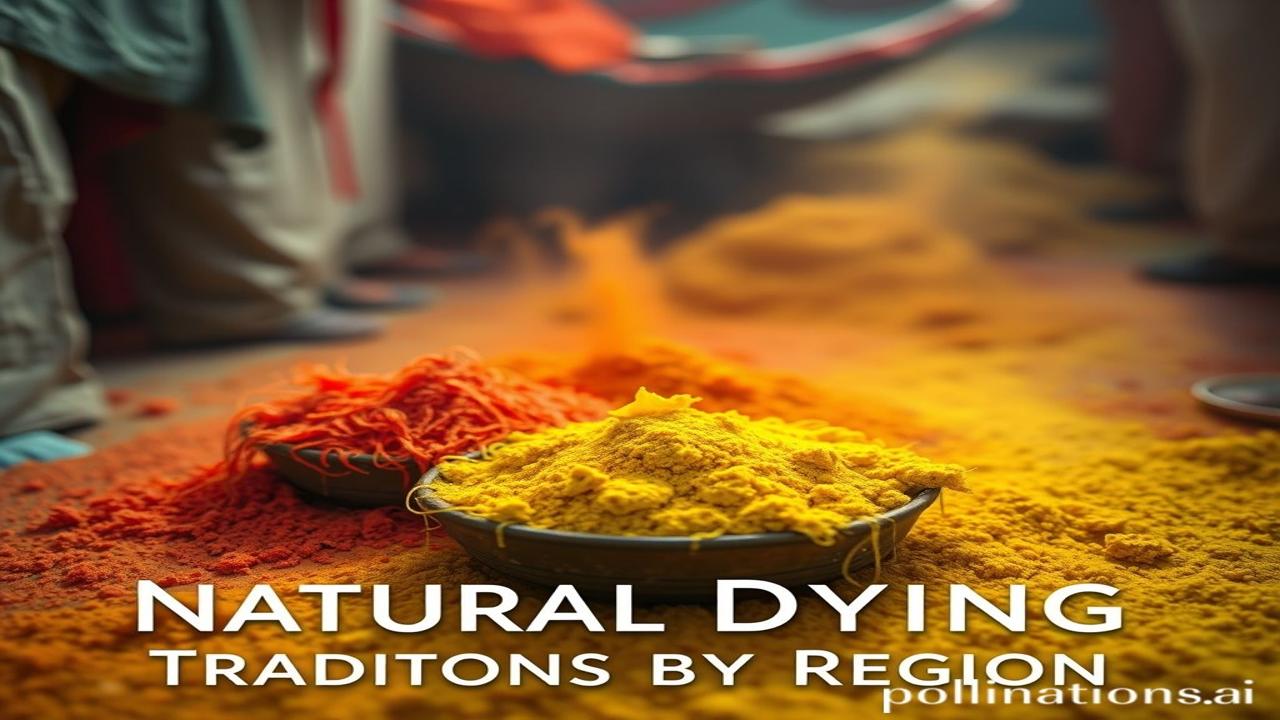Rangon Ki Zubaan: Exploring India’s Natural Dyeing Traditions by Region
Kabhi socha hai, woh dhage jinko hum roz pehente hain, unki bhi koi kahani hoti hai? Ek aisi kahani, jo mitti, paani, aur suraj ki roshni se shuru hoti hai? Imagine yourself standing in a vibrant marketplace centuries ago, the air thick with the earthy scent of freshly ground turmeric, the sweet fragrance of indigo leaves simmering in huge vats, and the soft murmur of women gossiping as they meticulously dyed yards of fabric. Yeh woh India hai, jahan har rang ek arth rakhta tha, har dhaga ek geet gaata tha. Let’s dive deep into the world of natural dyeing, a legacy etched in every thread of our cultural tapestry.
Natural Dyes: A Historical Canvas
Natural dyeing, simply put, is the art of extracting color from natural sources like plants, minerals, and even insects, to color fabrics. Its roots run deep in India. Archaeological evidence suggests that natural dyeing was practiced in the Indus Valley Civilization as early as 3000 BCE. Think about it – while the rest of the world was still figuring things out, humare yahan people were already mastering the art of creating vibrant textiles!
From humble beginnings, natural dyeing techniques flourished under various empires. The Mauryan, Gupta, and Mughal periods saw the refinement and standardization of these methods. Each region developed its unique signature style, using locally available resources to create dyes with distinct hues and patterns. The colours weren’t just aesthetic; they carried symbolic meanings, reflecting religious beliefs, social status, and regional identity. Imagine, colours acting like silent storytellers, weaving tales of kings, gods, and ordinary folks into every garment!
ज़मीनी सच – People and their Dyeing Lives
Let’s travel to Rajasthan, where the scorching desert sun beats down on the intricate bandhani patterns of saris. Picture a woman, her hands stained a deep crimson from manjistha root, carefully tying tiny knots on a piece of cloth. “Ae ji, is saree ko dekhna, yeh toh meri mehnat ka rang hai!” she might exclaim, pointing to the rich red hue.
Now, transport yourself to the lush green hills of Assam. Here, the silkworms are busy spinning their golden threads, destined to be dyed with lac, a resin secreted by insects. The process is a slow and deliberate one, reflecting the patience and artistry of the Assamese weavers. One can only imagine the pride of a weaver, gifting a mekhela chador dyed with natural pigments to a loved one, each thread carrying the essence of the land.
In the South, Tamil Nadu’s kalamkari artisans meticulously painted fabrics with natural dyes, using a bamboo pen to create intricate designs depicting scenes from the epics. Think about a master craftsman, his brow furrowed in concentration, bringing to life the stories of Rama and Krishna with every stroke. Each colour had significance – black for divinity, red for passion, and yellow for auspiciousness.
धरोहर और पहचान: Natural Dyes Today
Even in today’s fast-paced world, where synthetic dyes dominate the market, the legacy of natural dyeing continues to thrive. Across India, artisans and designers are rediscovering and reviving these ancient techniques. From sustainable fashion brands to grassroots organizations, there’s a growing awareness and appreciation for the beauty and ecological benefits of natural dyes.
Think of it – wearing a garment dyed with natural pigments is not just about fashion; it’s about connecting with our heritage, supporting sustainable practices, and embracing the slow, mindful approach to craftsmanship. Natural dyes are a powerful symbol of Bharatiyata, reminding us of our rich cultural heritage and the importance of respecting our environment.
मजेदार तथ्य या भ्रम-भंजक:
Log aksar samajhte hain ki natural dyes synthetic dyes se kam vibrant hote hain. Lekin asli sach yeh hai ki, properly extracted and applied natural dyes can be incredibly vibrant and long-lasting. The secret lies in the knowledge of the mordant, a substance that helps the dye bind to the fabric. Each region had its own unique mordant, like alum or harad, passed down through generations!
Another fun fact: Did you know that the costliest dye in the ancient world was Tyrian purple, extracted from sea snails? While India didn’t have Tyrian purple, our indigo dye was equally prized and traded across the globe!
दृश्य और भावनाएं:
Imagine walking through a village in Kutch, the air thick with the smell of sun-baked earth and simmering dye vats. The walls of the houses are adorned with vibrant bandhani textiles, each colour telling a different story. The sound of women singing traditional folk songs echoes in the air, as they meticulously tie and dye the fabrics, preserving a tradition that has been passed down for centuries. Feel the warmth of the sun on your skin, the soft texture of the hand-woven fabric, and the deep sense of connection to the land and its people.
अंतिम विचार या उद्धरण:
Natural dyeing is more than just a technique; it’s a philosophy, a way of life. It reminds us of the interconnectedness of nature and culture, the importance of preserving our heritage, and the beauty of embracing slow, sustainable practices. As the poet Kabir beautifully said:
“Rang birange phoolon se bhara hai bagh, par sabka rang ek hi mitti se hai.”
(The garden is filled with flowers of different colours, but all their colours come from the same earth.)
